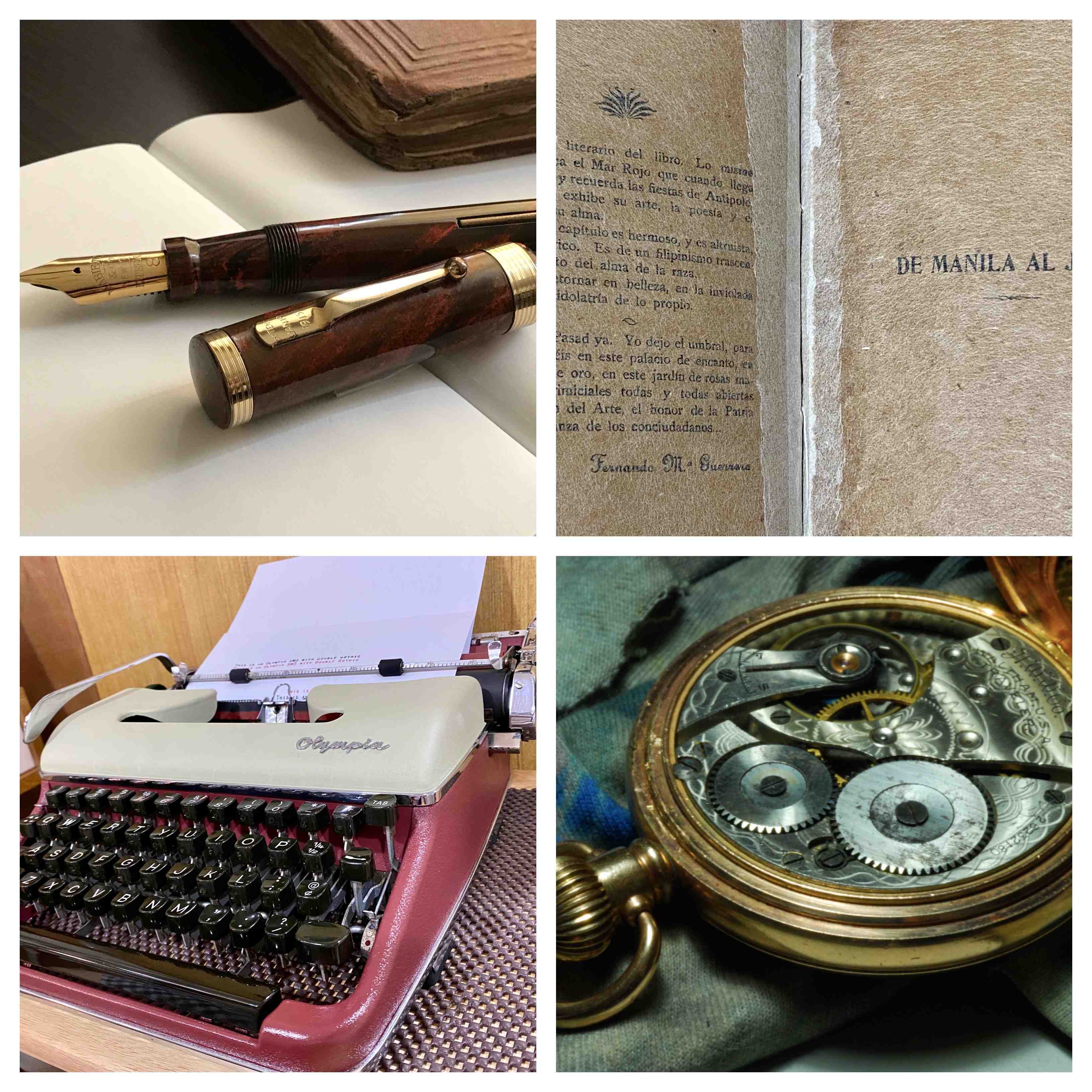Bringing new life to old
Revived and restored: (clockwise) a mid-1920s Swan Eternal 48 fountain pen; Teodoro M. Kalaw’s Hacia la Tierra del Zar from 1908; a Waltham Traveler pocket watch from around 1920; and an Olympia SM3 typewriter from 1959.
Being married to an art restorer who regularly salvages battered or tattered Amorsolos, HRs, Botongs, Kiukoks and the like and turns them into objects of joy and wonder again, I know what it’s like to give new life to something that at one point seemed utterly ruined.
Not that I can do it myself, as I’ve often been better at messing things up than fixing them. It’s a shame to admit, being a PSHS alum and an aspiring engineer at some wistful point, but I’m generally worthless around cars, for example. I can fix a flat if it comes to that, but anything else will have to be solved by a phone call to the tow truck. Neither is carpentry my strong suit; I’d probably break a saw before it could cut through a two-by-four, or lose a finger.
There are a few things that I’ve learned to repair — many old fountain pens, for example, though not all, as some require highly specialized skills and tools. Pens from the 1920s up to the 1950s that used rubber sacs or bladders are pretty easy to fix, with some help from a hair dryer to soften (but not melt) the plastic, and a dab of shellac. I can also DIY some basic computer fixes, like replacing laptop hard drives and batteries, making sure not to lose any tiny screws by mounting their heads on upside-down tape. As I collect pens and, yes, old Macs, this has not only saved me a mint on service fees but also amplified the pleasures of collecting and connoisseurship.
But I reserve my admiration for people who really know and love what they’re doing, are extremely good at it, and who are struggling to preserve a dying art as threatened as the objects they minister to.
We live in a repair-conscious society; unlike the throwaway Americans and even the Japanese, for whom labor could cost more than the appliance itself, we will fight to keep our TVs, fridges, aircons and electric fans chugging until their last breath. We suffocate our new sofas with plastic so they will live 100 years.
But repair is one thing, and restoration another. You can always buy another 60-inch TV if it can’t be fixed, but not another 1928 Parker Duofold Senior, or another signed copy of Carlos Bulosan’s America Is in the Heart, or another 1922 Corona 3 folding typewriter, at least not that cheaply or that easily.
Happily and thankfully, we still have people who, like my wife Beng, possess the arcane skills required to bring new life to old. And “old” is the operative word here, because the things they care for and care about tend to be far older than their owners and decidedly appeal to the senior set, although they’ve begun to acquire a certain charm for some millennials eager to connect to some thread of history.
Take vintage pens, for example. For those jobs that amateurs like me can’t do, there’s J.P. Reinoso, a retired bank executive, who’s turned his hobby into a full-on pen spa (yep, that’s what he calls it). Sheaffer Snorkels from the 1950s and Parker Vacumatics from the 1930s and 1940s will almost certainly defeat the uninitiated, but J.P. has the know-how and, just as importantly, the parts for them. (Sadly and surprisingly, modern piston-fillers like Montblancs and Pelikans will often require a long and expensive trip back to the factory in Germany for servicing, although some basic repairs can also be done here, subject to parts.)
For my old books that have begun to fall apart — and I mean books from as far back as the 1600s and 1700s, although books from the early 20th century tend to get more brittle and fragile because of their acidified paper — I turn for help to Josie Francisco of Bulwagang Recoletos, who uses gossamer-thin Japanese paper to make a crumbling page whole again. Another genius in this department is Loreto Apilado of the Ortigas Foundation Library, which accepts book restoration jobs.
Local watch aficionados swear by Andrew “Andy” Arnesto, whose shop at Makati Cinema Square has become a mecca for savvy collectors and users seeking to revive their vintage Rolexes and Omegas without having to pay boutique rates, especially for the simplest fixes.
And what about those typewriters? I’ve written about him here before, but the guy we call Gerald Cha, based in Quiapo, is still the go-to person to get your Lolo’s venerable Underwood 5 or Smith-Corona Silent Super going clackety-clack again. Beyond giving your machine the basic CLA (cleaning, lubrication, adjustment) service, he can also repaint it to your specifications — like he did with a dull-olive 1959 Olympia SM3 that I fancied turning into my “UP Naming Mahal” standard-bearer, with its maroon-and-cream body accented by the original green platen knobs.
As I quoted Hippocrates last week, ars longa, vita brevis — art is long, life is short. Taken another way, a bit of the restorer’s art can lengthen the life of your dearest toys and possessions.
(Privacy concerns inhibit me from giving out their numbers, but a little Googling should go a long way.)
* * *
Email me at jose@dalisay.ph and visit my blog at www.penmanila.ph.


